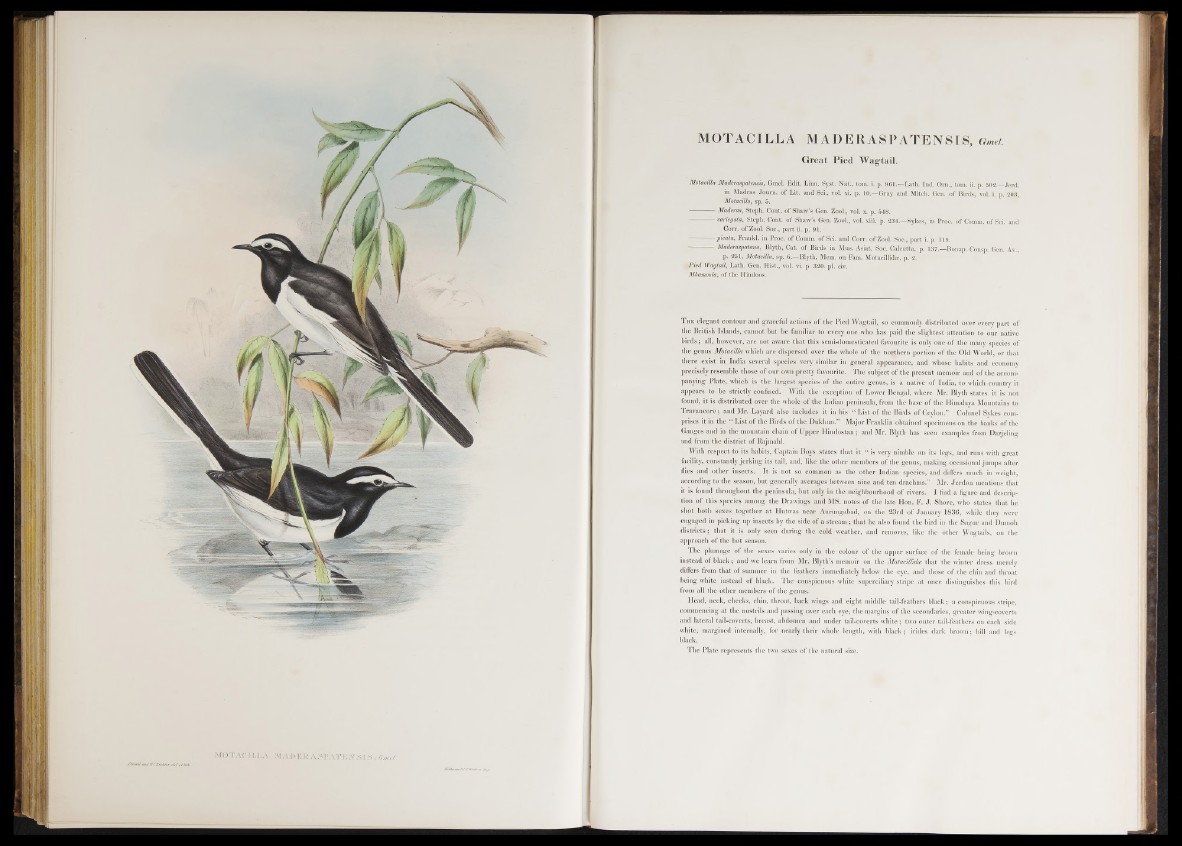
MOTACILLA MADERASPATENSIS, Gmei.
Great Pied Wagtail.
Motacilla Malermpalemis, Gmel. Edit. Linn. Syst. Nat., (,6111. i: p. yGlgL a th . Ind. Om., fom. ii. p. 502.—Jerd.
in Madras Jonm. of Lit. and Sci., vol. xi. p. 10.—Gray and Mitch. Gen. of Birds, vol. i. p. 203,
Motacilla, sp. 5.
Maderas, Steph. Cont. of Shaw’s Gen. Zool., vol. x. p. 548.
— variegata, Steph. Cont. of Shaw’s Gen. Zool., vol. xiii. p. 234.—Sykes, in Proc. of Comm, of Sci. and
Corr. of Zool. Soc., part ii. p. 91.
picata, Frankl. in Proc. of Comm, of Sci. and Corr. of Zool. Soc., part i. p. 119.
— Maderaspatana, Blyth, Cat. of Birds in Mus. Asiat. Soc. Calcutta, p. 137.—Bonap. Consp. Gen. Av.,
p. 251, Motacilla, sp. 6.—Blyth, Mem. on Fam. MotacillidiE, p. 2.
Pied Wagtail, Lath. Gen. Hist., vol. vi. p. 320. pi. civ.
Mliamoola, of the Hindoos.
T he elegant contour and graceful'actions of the Pied Wagtail, so commonly distributed over every part of
the British Islands, cannot but be familiar to every one who has paid the slightest attention to our native
birds; all, however, are not aware that this semi-domesticated favourite is only one o f the many species of
the genus Motacilla which are dispersed over the whole of the northern portion of the Old World, or that
there exist in India several species very similar in general appearance, and whose habits and economy
precisely resemble those of our own p retty favourite. The subject o f the present memoir and of the accompanying
Plate, which is the largest species o f the entire genus, is a native of India, to which country it
appears to be strictly confined. With the exception of Lower Bengal, where Mr. Blyth states it is not
found, it is distributed over the whole of the Indian peninsula, from the base of the Himalaya Mountains to
Travancore; and Mr. Layard also includes it in his “ List of the Birds o f Qeyton.” Colonel Sykes comprises
it in the “ List o f the Birds of the Dukhun.” Major Franklin obtained specimens on the banks o f the
Ganges and in the mountain chain of Upper Hindostán; and Mr. Blyth has seen examples from Darjeling
and from the district of Rajmahl.
With respect to its habits, Captain Boys states that it “ is very nimble on its legs, and runs with great
facility, constantly jerking its tail, and, like the other members o f the genus, making occasiQnal jumps after
flies and other insects. It is not so common as the other Indian species, and differs much in weight,
according to the season, but generally averages between nine and ten drachms.” Mr. Jerdon mentions that
it is found throughout the peninsula, but only in the neighbourhood o f rivers. I find a figure and description
o f this species among the Drawings and MS. notes o f the late Hon. F. J . Shore, who states that he
shot both sexes together a t Hutwas near Aurungabad, on the 23rd o f January 1836, while they were
engaged in picking up insects by the side of a stream; that he also found the bird in the Sagur and Dumoh
districts; that it is only seen during the cold weather, and removes, like the other Wagtails, on the
approach of the hot season.
The plumage o f the sexes varies only in the colour of the upper surface of the female being brown
instead of black; and we learn from Mr. Blyth’s memoir on the Motacillidce that the winter dress merely
differs from that of summer in the feathers immediately below the eye, and those of the chin and throat
being white instead of black. The conspicuous white superciliary stripe at once distinguishes this bird
from all the other members of the genus.
Head, neck, cheeks, chin, throat, back wings and eight middle tail-feathers black; a conspicuous stripe,
commencing a t the nostrils and passing over each eye, the margins of the secondaries, greater wing-coverts
and lateral tail-coverts, breast, abdomen and under tail-coverts white; two outer tail-feathers on each side
white, margined internally, for nearly their whole length, with black; irides dark brown; bill and legs
black.
The Plate represents the two sexes of the natural size.